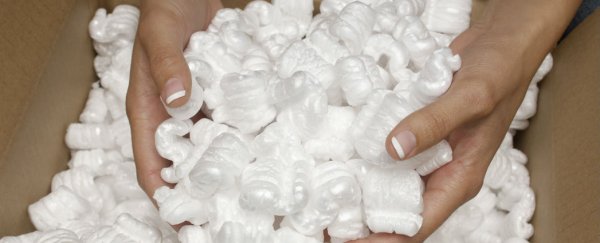Packing peanuts are awful. About 1.5 million tonnes of these expanded polystyrene (EPS) padding materials are produced each year worldwide, and only about 10 percent of that ends up being recycled. In Australia, that figure is closer to 7 percent, because if you want to recycle your packing peanuts, you can't put them in the recycling bin - you have to bring them to a special collection site, which isn't something most people are willing to do.
Once in landfill, these little noodles can take several hundred years to decompose. It's such a problem that packing peanuts and polystyrene cups and takeaway containers have been banned in New York City, effective from July 1st.
And now researchers at Purdue University in the US have figured out how to recycle the tonnes and tonnes and tonnes of peanuts that have ended up in the waste pile - they're turning them into super-effective battery components.
To have a functioning battery, you need two types of electrodes - an anode, and a cathode. The anodes contain a liquid called electrolyte, which stores the lithium ions as the battery is being recharged. Right now, most lithium-ion batteries contain anodes made from graphite, but the team has discovered that by heating the peanuts to between 500 and 900 degrees Celsius, they can produce super-slim carbon-nanoparticle sheets which can be used to make the perfect anode.
And when we say "perfect", we mean better than what's currently on the market. The team will report at the 249th American Chemical Society National Meeting & Exposition in the US this week that their new anodes can charge faster and deliver higher "specific capacity" than any other commercially available graphite anodes. They're also about 10 times thinner than regular anodes.
"In our case, if we are lithiating this material during the charging of a battery, it has to travel only 1 micrometre distance, so you can charge and discharge a battery faster than your commercially available material," said one of the team, chemical engineer Vilas Pol, in a press release. "These electrodes exhibited notably higher lithium-ion storage performance compared to the commercially available graphite anodes."
Not only that, but the process to make these anodes is cheap, and easily scalable, the team reports.
"The process is inexpensive, environmentally benign and potentially practical for large-scale manufacturing," his colleague, Vinodkumar Etacheri, added. "Microscopic and spectroscopic analyses proved the microstructures and morphologies responsible for superior electrochemical performances are preserved after many charge-discharge cycles."
When tested in their lab, the peanut anodes clocked a capacity of 420 mAh/g (milliamp hours per gram), which is higher than the theoretical limit for graphite, which is 372 mAh/g.
"Long-term electrochemical performances of these carbon electrodes are very stable," said Pol. "We cycled it 300 times without significant capacity loss. These carbonaceous electrodes are also promising for rechargeable sodium-ion batteries. Future work will include steps to potentially improve performance by further activation to increase the surface area and pore size to improve the electrochemical performance."
This is such a great idea, and if we have to go digging through our landfill to retrieve some 100-year-old packing peanuts, this would make it all worthwhile.
You can find the abstract of the paper the team will present to their peers this week at Phys.org.
